Lexell's theorem
In spherical geometry, Lexell's theorem holds that every spherical triangle with the same surface area on a fixed base has its apex on a small circle, called Lexell's circle or Lexell's locus,[1] passing through two points antipodal to the two base vertices.
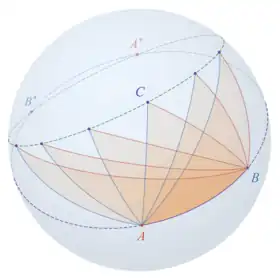
The theorem is named for Anders Johan Lexell, who presented a paper about it c. 1777 (published 1784) including both a trigonometric proof and a geometric one.[2] Lexell's colleague Leonhard Euler wrote another pair of proofs in 1778 (published 1797), and a variety of proofs have been written since by Adrien-Marie Legendre (1800), Jakob Steiner (1827), Carl Friedrich Gauss (1841), Paul Serret (1855), and Joseph-Émile Barbier (1864), among others.[3]
The theorem is the analog of propositions 37 and 39 in Book I of Euclid's Elements, which prove that every planar triangle with the same area on a fixed base has its apex on a straight line parallel to the base.[4] An analogous theorem can also be proven for hyperbolic triangles, for which the apex lies on a hypercycle.
Statement

Given a fixed base an arc of a great circle on a sphere, and two apex points and on the same side of great circle Lexell's theorem holds that the surface area of the spherical triangle is equal to that of if and only if lies on the small-circle arc where and are the points antipodal to and respectively.
As one analog of the planar formula for the area of a triangle, the spherical excess of spherical triangle can be computed in terms of the base (the angular length of arc ) and "height" (the angular distance between the parallel small circles and ):[5]
In the limit for triangles much smaller than the radius of the sphere, this reduces to the planar formula.
The small circles and each intersect the great circle at an angle of [6]
Proofs
There are several ways to prove Lexell's theorem, each illuminating a different aspect of the relationships involved.
Isosceles triangles

The main idea in Lexell's c. 1777 geometric proof – also adopted by Eugène Catalan (1843), Robert Allardice (1883), Jacques Hadamard (1901), Antoine Gob (1922), and Hiroshi Maehara (1999) – is to split the triangle into three isosceles triangles with common apex at the circumcenter and then chase angles to find the spherical excess of triangle In the figure, points and are on the far side of the sphere so that we can clearly see their antipodal points and all of Lexell's circle [7]
Let the base angles of the isosceles triangles (shaded red in the figure), (blue), and (purple) be respectively and (In some cases is outside ; then one of the quantities will be negative.) We can compute the internal angles of (orange) in terms of these angles: (the supplement of ) and likewise and finally
By Girard's theorem the spherical excess of is
If base is fixed, for any third vertex falling on the same arc of Lexell's circle, the point and therefore the quantity will not change, so the excess of which depends only on will likewise be constant. And vice versa: if remains constant when the point is changed, then so must be, and therefore must be fixed, so must remain on Lexell's circle.
Cyclic quadrilateral

Jakob Steiner (1827) wrote a proof in similar style to Lexell's, also using Girard's theorem, but demonstrating the angle invariants in the triangle by constructing a cyclic quadrilateral inside the Lexell circle, using the property that pairs of opposite angles in a spherical cyclic quadrilateral have the same sum.[8][9]
Starting with a triangle , let be the Lexell circle circumscribing and let be another point on separated from by the great circle Let
Because the quadrilateral is cyclic, the sum of each pair of its opposite angles is equal, or rearranged
By Girard's theorem the spherical excess of is
The quantity does not depend on the choice of so is invariant when is moved to another point on the same arc of Therefore is also invariant.
Conversely, if is changed but is invariant, then the opposite angles of the quadrilateral will have the same sum, which implies lies on the small circle
Spherical parallelograms
Euler in 1778 proved Lexell's theorem analogously to Euclid's proof of Elements I.35 and I.37, as did Victor-Amédée Lebesgue independently in 1855, using spherical parallelograms – spherical quadrilaterals with congruent opposite sides, which have parallel small circles passing through opposite pairs of adjacent vertices and are in many ways analogous to Euclidean parallelograms. There is one complication compared to Euclid's proof, however: The four sides of a spherical parallelogram are the great-circle arcs through the vertices rather than the parallel small circles. Euclid's proof does not need to account for the small lens-shaped regions sandwiched between the great and small circles, which vanish in the planar case.[10]
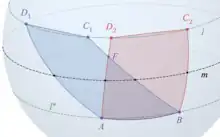
A lemma analogous to Elements I.35: two spherical parallelograms on the same base and between the same parallels have equal area.
Proof: Let and be spherical parallelograms with the great circle (the "midpoint circle") passing through the midpoints of sides and coinciding with the corresponding midpoint circle in Let be the intersection point between sides and Because the midpoint circle is shared, the two top sides and lie on the same small circle parallel to and antipodal to a small circle passing through and
Two arcs of are congruent, thus the two curvilinear triangles and each bounded by on the top side, are congruent. Each parallelogram is formed from one of these curvilinear triangles added to the triangle and to one of the congruent lens-shaped regions between each top side and with the curvilinear triangle cut away. Therefore, the parallelograms have the same area. (As in Elements, the case where the parallelograms do not intersect on the sides is omitted, but can be proven by a similar argument.)
Proof of Lexell's theorem: Given two spherical triangles and each with its apex on the same small circle through points and construct new segments and congruent to with vertices and on The two quadrilaterals and are spherical parallelograms, each formed by pasting together the respective triangle and a congruent copy. By the lemma, the two parallelograms have the same area, so the original triangles must also have the same area.
Proof of the converse: If two spherical triangles have the same area and the apex of the second is assumed to not lie on the Lexell circle of the first, then the line through one side of the second triangle can be intersected with the Lexell circle to form a new triangle which has a different area from the second triangle but the same area as the first triangle, a contradiction. This argument is the same as that found in Elements I.39.
Saccheri quadrilateral

Another proof using the midpoint circle which is more visually apparent in a single picture is due to Carl Friedrich Gauss (1841), who constructs the Saccheri quadrilateral (a quadrilateral with two adjacent right angles and two other equal angles) formed between the side of the triangle and its perpendicular projection onto the midpoint circle [11] which has the same area as the triangle.[12]
Let be the great circle through the midpoints of and of and let and be the perpendicular projections of the triangle vertices onto The resulting pair of right triangles and (shaded red) have equal angles at (vertical angles) and equal hypotenuses, so they are congruent; so are the triangles and (blue). Therefore the area of triangle is equal to the area of Saccheri quadrilateral as each consists of one red triangle, one blue triangle, and the green quadrilateral pasted together. (If falls outside the arc then either the red or blue triangles will have negative signed area.) Because the great circle and therefore the quadrilateral is the same for any choice of lying on the Lexell circle the area of the corresponding triangle is constant.
Stereographic projection
The stereographic projection maps the sphere to the plane. A designated great circle is mapped onto the primitive circle in the plane, and its poles are mapped to the origin (center of the primitive circle) and the point at infinity, respectively. Every circle on the sphere is mapped to a circle or straight line in the plane, with straight lines representing circles through the second pole. The stereographic projection is conformal, meaning it preserves angles.
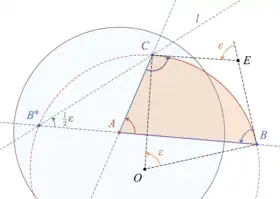
To prove relationships about a general spherical triangle without loss of generality vertex can be taken as the point which projects to the origin. The sides of the spherical triangle then project to two straight segments and a circular arc. If the tangent lines to the circular side at the other two vertices intersect at point a planar straight-sided quadrilateral can be formed whose external angle at is the spherical excess of the spherical triangle. This is sometimes called the Cesàro method of spherical trigonometry, after crystallographer Giuseppe Cesàro who popularized it in two 1905 papers.[13]
Paul Serret (in 1855, a half century before Cesàro), and independently Aleksander Simonič (2019), used Cesàro's method to prove Lexell's theorem. Let be the center in the plane of the circular arc to which side projects. Then is a right kite, so the central angle is equal to the external angle at the triangle's spherical excess Planar angle is an inscribed angle subtending the same arc, so by the inscribed angle theorem has measure This relationship is preserved for any choice of ; therefore, the spherical excess of the triangle is constant whenever remains on the Lexell circle which projects to a line through in the plane. (If the area of the triangle is greater than a half-hemisphere, a similar argument can be made, but the point is no longer internal to the angle )[14]
Perimeter of the polar triangle

Every spherical triangle has a dual, its polar triangle; if triangle (shaded purple) is the polar triangle of (shaded orange) then the vertices are the poles of the respective sides and vice versa, the vertices are the poles of the sides The polar duality exchanges the sides (central angles) and external angles (dihedral angles) between the two triangles.
Because each side of the dual triangle is the supplement of an internal angle of the original triangle, the spherical excess of is a function of the perimeter of the dual triangle :
where the notation means the angular length of the great-circle arc
In 1854 Joseph-Émile Barbier – and independently László Fejes Tóth (1953) – used the polar triangle in his proof of Lexell's theorem, which is essentially dual to the proof by isosceles triangles above, noting that under polar duality the Lexell circle circumscribing becomes an excircle of (incircle of a colunar triangle) externally tangent to side [15]
If vertex is moved along the side changes but always remains tangent to the same circle Because the arcs from each vertex to either adjacent touch point of an incircle or excircle are congruent, (blue segments) and (red segments), the perimeter is
which remains constant, depending only on the circle but not on the changing side Conversely, if the point moves off of the associated excircle will change in size, moving the points and both toward or both away from and changing the perimeter of and thus changing
The locus of points for which is constant is therefore
Trigonometric proofs
Both Lexell (c. 1777) and Euler (1778) included trigonometric proofs in their papers, and several later mathematicians have presented trigonometric proofs, including Adrien-Marie Legendre (1800), Louis Puissant (1842), Ignace-Louis-Alfred Le Cointe (1858), and Joseph-Alfred Serret (1862). Such proofs start from known triangle relations such as the spherical law of cosines or a formula for spherical excess, and then proceed by algebraic manipulation of trigonometric identities.[16]
Opposite arcs of Lexell's circle
The sphere is separated into two hemispheres by the great circle and any Lexell circle through and is separated into two arcs, one in each hemisphere. If the point is on the opposite arc from then the areas of and will generally differ. However, if spherical surface area is interpreted to be signed, with sign determined by boundary orientation, then the areas of triangle and have opposite signs and differ by the area of a hemisphere.
Lexell suggested a more general framing. Given two distinct non-antipodal points and there are two great-circle arcs joining them: one shorter than a semicircle and the other longer. Given a triple of points, typically is interpreted to mean the area enclosed by the three shorter arcs joining each pair. However, if we allow choice of arc for each pair, then 8 distinct generalized spherical triangles can be made, some with self intersections, of which four might be considered to have the same base
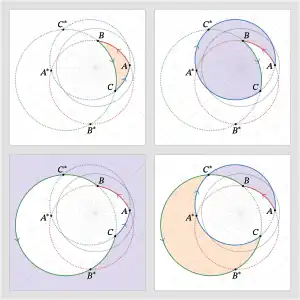
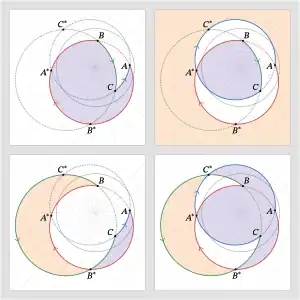
These eight triangles do not all have the same surface area, but if area is interpreted to be signed, with sign determined by boundary orientation, then those which differ differ by the area of a hemisphere.[17]
In this context, given four distinct, non-antipodal points and on a sphere, Lexell's theorem holds that the signed surface area of any generalized triangle differs from that of any generalized triangle by a whole number of hemispheres if and only if and are concyclic.
Special cases
Lunar degeneracy

As the apex approaches either of the points antipodal to the base vertices – say – along Lexell's circle in the limit the triangle degenerates to a lune tangent to at and tangent to the antipodal small circle at and having the same excess as any of the triangles with apex on the same arc of As a degenerate triangle, it has a straight angle at (i.e. a half turn) and equal angles [18]
As approaches from the opposite direction (along the other arc of Lexell's circle), in the limit the triangle degenerates to the co-hemispherical lune tangent to the Lexell circle at with the opposite orientation and angles
Half-hemisphere area
The area of a spherical triangle is equal to half a hemisphere (excess ) if and only if the Lexell circle is orthogonal to the great circle that is if arc is a diameter of circle and arc is a diameter of
In this case, letting be the point diametrically opposed to on the Lexell circle then the four triangles and are congruent, and together form a spherical disphenoid (the central projection of a disphenoid onto a concentric sphere). The eight points are the vertices of a rectangular cuboid.[19]
Related concepts and results
Spherical parallelogram
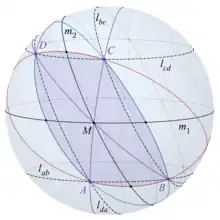
A spherical parallelogram is a spherical quadrilateral whose opposite sides and opposite angles are congruent ( ). It is in many ways analogous to a planar parallelogram. The two diagonals and bisect each-other and the figure has 2-fold rotational symmetry about the intersection point (so the diagonals each split the parallelogram into two congruent spherical triangles, and ); if the midpoints of either pair of opposite sides are connected by a great circle , the four vertices fall on two parallel small circles equidistant from it. More specifically, any vertex (say ) of the spherical parallelogram lies at the intersection of the two Lexell circles ( and ) passing through one of the adjacent vertices and the points antipodal to the other two vertices.
As with spherical triangles, spherical parallelograms with the same base and the apex vertices lying on the same Lexell circle have the same area; see § Spherical parallelograms above. Starting from any spherical triangle, a second congruent triangle can be formed via a (spherical) point reflection across the midpoint of any side. When combined, these two triangles form a spherical parallelogram with twice the area of the original triangle.[20]
Sorlin's theorem (polar dual)
The polar dual to Lexell's theorem, sometimes called Sorlin's theorem after A. N. J. Sorlin who first proved it trigonometrically in 1825, holds that for a spherical trilateral with sides on fixed great circles (thus fixing the angle between them) and a fixed perimeter (where means the length of the triangle side ), the envelope of the third side is a small circle internally tangent to and externally tangent to the excircle to trilateral Joseph-Émile Barbier later wrote a geometrical proof (1864) which he used to prove Lexell's theorem, by duality; see § Perimeter of the polar triangle above.[21]
This result also applies in Euclidean and hyperbolic geometry: Barbier's geometrical argument can be transplanted directly to the Euclidean or hyperbolic plane.
Foliation of the sphere

Lexell's loci for any base make a foliation of the sphere (decomposition into one-dimensional leaves). These loci are arcs of small circles with endpoints at and on which any intermediate point is the apex of a triangle of a fixed signed area. That area is twice the signed angle between the Lexell circle and the great circle at either of the points or ; see § Lunar degeneracy above. In the figure, the Lexell circles are in green, except for those whose triangles' area is a multiple of a half hemisphere, which are black, with area labeled; see § Half-hemisphere area above.[22]
These Lexell circles through and are the spherical analog of the family of Apollonian circles through two points in the plane.
Maximizing spherical triangle area subject to constraints
In 1784 Nicolas Fuss posed and solved the problem of finding the triangle of maximal area on a given base with its apex on a given great circle Fuss used an argument involving infinitesimal variation of but the solution is also a straight-forward corollary of Lexell's theorem: the Lexell circle through the apex must be tangent to at
If crosses the great circle through at a point , then by the spherical analog of the tangent–secant theorem, the angular distance to the desired point of tangency satisfies
from which we can explicitly construct the point on such that has maximum area.[23]
In 1786 Theodor von Schubert posed and solved the problem of finding the spherical triangles of maximum and minimum area of a given base and altitude (the spherical length of a perpendicular dropped from the apex to the great circle containing the base); spherical triangles with constant altitude have their apex on a common small circle (the "altitude circle") parallel to the great circle containing the base. Schubert solved this problem by a calculus-based trigonometric approach to show that the triangle of minimal area has its apex at the nearest intersection of the altitude circle and the perpendicular bisector of the base, and the triangle of maximal area has its apex at the far intersection. However, this theorem is also a straight-forward corollary of Lexell's theorem: the Lexell circles through the points antipodal to the base vertices representing the smallest and largest triangle areas are those tangent to the altitude circle. In 2019 Vincent Alberge and Elena Frenkel solved the analogous problem in the hyperbolic plane.[24]
Steiner's theorem on area bisectors

In the Euclidean plane, a median of a triangle is the line segment connecting a vertex to the midpoint of the opposite side. The three medians of a triangle all intersect at its centroid. Each median bisects the triangle's area.
On the sphere, a median of a triangle can also be defined as the great-circle arc connecting a vertex to the midpoint of the opposite side. The three medians all intersect at a point, the central projection onto the sphere of the triangle's extrinsic centroid – that is, centroid of the flat triangle containing the three points if the sphere is embedded in 3-dimensional Euclidean space. However, on the sphere the great-circle arc through one vertex and a point on the opposite side which bisects the triangle's area is, in general, distinct from the corresponding median.
Jakob Steiner used Lexell's theorem to prove that these three area-bisecting arcs (which he called "equalizers") all intersect in a point, one possible alternative analog of the planar centroid in spherical geometry. (A different spherical analog of the centroid is the apex of three triangles of equal area whose bases are the sides of the original triangle, the point with as its spherical area coordinates.)[25]
Spherical area coordinates

The barycentric coordinate system for points relative to a given triangle in affine space does not have a perfect analogy in spherical geometry; there is no single spherical coordinate system sharing all of its properties. One partial analogy is spherical area coordinates for a point relative to a given spherical triangle
where each quantity is the signed spherical excess of the corresponding spherical triangle These coordinates sum to and using the same definition in the plane results in barycentric coordinates.
By Lexell's theorem, the locus of points with one coordinate constant is the corresponding Lexell circle. It is thus possible to find the point corresponding to a given triple of spherical area coordinates by intersecting two small circles.
Using their respective spherical area coordinates, any spherical triangle can be mapped to any other, or to any planar triangle, using corresponding barycentric coordinates in the plane. This can be used for polyhedral map projections; for the definition of discrete global grids; or for parametrizing triangulations of the sphere or texture mapping any triangular mesh topologically equivalent to a sphere.[26]
Euclidean plane
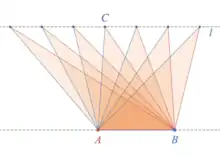
The analog of Lexell's theorem in the Euclidean plane comes from antiquity, and can be found in Book I of Euclid's Elements, propositions 37 and 39, built on proposition 35. In the plane, Lexell's circle degenerates to a straight line (which could be called Lexell's line) parallel to the base.[4]

Elements I.35 holds that parallelograms with the same base whose top sides are colinear have equal area. Proof: Let the two parallelograms be and with common base and and on a common line parallel to the base, and let be the intersection between and Then the two top sides are congruent so, adding the intermediate segment to each, Therefore the two triangles and have matching sides so are congruent. Now each of the parallelograms is formed from one of these triangles, added to the triangle with the triangle cut away, so therefore the two parallelograms and have equal area.
Elements I.37 holds that triangles with the same base and an apex on the same line parallel to the base have equal area. Proof: Let triangles and each have its apex on the same line parallel to the base Construct new segments and congruent to with vertices and on The two quadrilaterals and are parallelograms, each formed by pasting together the respective triangle and a congruent copy. By I.35, the two parallelograms have the same area, so the original triangles must also have the same area.
Elements I.39 is the converse: two triangles of equal area on the same side of the same base have their apexes on a line parallel to the base. Proof: If two triangles have the same base and same area and the apex of the second is assumed to not lie on the line parallel to the base (the "Lexell line") through the first, then the line through one side of the second triangle can be intersected with the Lexell line to form a new triangle which has a different area from the second triangle but the same area as the first triangle, a contradiction.
In the Euclidean plane, the area of triangle can be computed using any side length (the base) and the distance between the line through the base and the parallel line through the apex (the corresponding height). Using point as the apex, and multiplying both sides of the traditional identity by to make the analogy to the spherical case more obvious, this is:
The Euclidean theorem can be taken as a corollary of Lexell's theorem on the sphere. It is the limiting case as the curvature of the sphere approaches zero, i.e. for spherical triangles as which are infinitesimal in proportion to the radius of the sphere.
Hyperbolic plane
.png.webp)
In the hyperbolic plane, given a triangle the locus of a variable point such that the triangle has the same area as is a hypercycle passing through the points antipodal to and which could be called Lexell's hypercycle. Several proofs from the sphere have straightforward analogs in the hyperbolic plane, including a Gauss-style proof via a Saccheri quadrilateral by Barbarin (1902) and Frenkel & Su (2019), an Euler-style proof via hyperbolic parallelograms by Papadopoulos & Su (2017), and a Paul Serret-style proof via stereographic projection by Shvartsman (2007).[27]
In spherical geometry, the antipodal transformation takes each point to its antipodal (diametrically opposite) point. For a sphere embedded in Euclidean space, this is a point reflection through the center of the sphere; for a sphere stereographically projected to the plane, it is an inversion across the primitive circle composed with a point reflection across the origin (or equivalently, an inversion in a circle of imaginary radius of the same magnitude as the radius of the primitive circle).
In planar hyperbolic geometry, there is a similar antipodal transformation, but any two antipodal points lie in opposite branches of a double hyperbolic plane. For a hyperboloid of two sheets embedded in Minkowski space of signature known as the hyperboloid model, the antipodal transformation is a point reflection through the center of the hyperboloid which takes each point onto the opposite sheet; in the conformal half-plane model it is a reflection across the boundary line of ideal points taking each point into the opposite half-plane; in the conformal disk model it is an inversion across the boundary circle, taking each point in the disk to a point in its complement. As on the sphere, any generalized circle passing through a pair of antipodal points in hyperbolic geometry is a geodesic.[28]
Analogous to the planar and spherical triangle area formulas, the hyperbolic area of the triangle can be computed in terms of the base (the hyperbolic length of arc ) and "height" (the hyperbolic distance between the parallel hypercycles and ):
As in the spherical case, in the small-triangle limit this reduces to the planar formula.
Notes
- Todhunter & Leathem 1901, § 153. Lexell's locus, pp. 118–119
- Lexell 1784, Stén 2014, Atzema 2017, Zhukova 2019
- See Papadopoulos (2014) and Atzema (2017) about the early history, and Maehara & Martini (2023) for a variety of proofs. For further context, see: Chasles, Michel (1837), Aperçu historique sur l'origine et le développment des méthodes en géométrie [Historical overview of the origin and development of methods in geometry] (in French), Brussels: Hayez, Ch. 5, §§ 42–45, "Géométrie de la sphère" [Spherical geometry], pp. 235–240
- Euclid (c. 300 BCE), Elements, Prop. I.35: "Parallelograms which are on the same base and in the same parallels equal one another." Prop. I.37: "Triangles which are on the same base and in the same parallels equal one another." Prop. I.39: "Equal triangles which are on the same base and on the same side are also in the same parallels."
-
Puissant (1842) expresses this in terms of the radius of Lexell's circle, as does Euler (1797) who mistakenly writes instead of
If is the radius of Lexell's circle, Note that is the shortest angular distance from to the small circle not the shortest distance from to the great circle
- See § Stereographic projection below for a proof of this.
- Lexell 1784, Atzema 2017, Maehara & Martini 2023 The same basic idea was used in: Catalan, Eugène Charles (1843), "Livre 7, Problème 7. Quel est le lieu géométrique des sommets des triangles sphériques de méme base et de méme surface?" [What is the locus of the apices of spherical triangles with the same base and the same area?], Éléments de géométrie (in French), Bachelier, pp. 271–272 Allardice, Robert Edgar (1883), "Spherical Geometry", Proceedings of the Edinburgh Mathematical Society, 2: 8–16, doi:10.1017/S0013091500037020 Hadamard, Jacques (1901), "§ 697. Théorème de Lexell.", Leçons de géométrie élémentaire [Lessons in elementary geometry] (in French), vol. 2: Géométrie dans l'espace [Geometry in space], Armand Colin, pp. 392–393 Gob, Antoine (1922), "Notes de géometrie et de trigonométrie spheriques" [Notes on geometry and spherical trigonometry], Mémoires de la Société Royale des Sciences de Liège, ser. 3 (in French), 11, No. 3 (pp. 1–29) Maehara, Hiroshi (1999), "Lexell's theorem via an inscribed angle theorem", American Mathematical Monthly, 106 (4): 352–353, doi:10.1080/00029890.1999.12005052
- This property was first proven in: Lexell, Anders Johan (1786), "De proprietatibus circulorum in superficie sphaerica descriptorum" [On the properties of circles described on a spherical surface], Acta Academiae Scientiarum Imperialis Petropolitanae (in Latin), 6: 1782 (1): 58–103, figures tab. 3
- Papadopoulos 2014, Atzema 2017, Maehara & Martini 2023 Steiner, Jakob (1827), "Verwandlung und Theilung sphärischer Figuren durch Construction" [Transformation and Division of Spherical Figures by Construction], Journal für die reine und angewandte Mathematik (in German), 2 (1): 45–63, doi:10.1515/crll.1827.2.45, EuDML 183090 "Théorème de Lexell, et transformation des polygones sphériques, d'après M. Steiner" [Lexell's theorem, and transformation of spherical polygons, after Mr. Steiner], Nouvelles Annales de Mathématiques (in French), 4: 587–590, 1845, EuDML 95439 Steiner, Jakob (1841), "Sur le maximum et le minimum des figures dans le plan, sur la sphère et dans l'espace général" [On the maximum and the minimum of figures in the plane, on the sphere and in general space], Journal de mathématiques pures et appliquées (in French), 6: 105–170, EuDML 234575
- Euler 1797, Papadopoulos 2014, Atzema 2017, Maehara & Martini 2023 Essentially the same proof is found in: Lebesgue, Victor-Amédée (1855), "Démonstration du théorème de Lexell", Nouvelles annales de mathématiques (in French), 14: 24–26, EuDML 96674
- By perpendicular projection of a point onto a great circle we mean the foot of the altitude through i.e. the intersection between and the great circle which is perpendicular to and passes through
- Atzema 2017, Maehara & Martini 2023 Gauss wrote this proof in a letter to Heinrich Christian Schumacher in 1841, in response to a related proof from Thomas Clausen sent to him by Schumacher. The correspondence was later published in: Gauss, Carl Friedrich; Schumacher, Heinrich Christian (1862), Peters, Christian August Friedrich (ed.), Briefwechsel zwischen C. F. Gauss und H. C. Schumacher, vol. 4, Gustav Esch, pp. 46–49 The same proof can also be found in: Persson, Ulf (2012), "Lexell's Theorem" (PDF), Normat, 60 (3): 133–134
- Cesàro, Giuseppe (1905), "Nouvelle méthode pour l'établissement des formules de la trigonométrie sphérique" [New method for establishing the formulas of spherical trigonometry], Académie royale de Belgique: Bulletins de la Classe des sciences, ser. 4 (in French), 7 (9–10): 434–454 Cesàro, Giuseppe (1905), "Les formules de la trigonométrie sphérique déduites de la projection stéréographique du triangle. – Emploi de cette projection dans les recherches sur la sphère" [The formulas of spherical trigonometry deduced by spherical projection of the triangle. – Use of this projection in researches on the sphere], Académie royale de Belgique: Bulletins de la Classe des sciences, ser. 4 (in French), 7 (12): 560–584 Donnay, Joseph Desire Hubert (1945), Spherical Trigonometry after the Cesàro Method, New York: Interscience Van Brummelen, Glen (2012), "8. Stereographic Projection", Heavenly Mathematics, Princeton University Press, pp. 129–150
- Maehara & Martini 2023 Serret, Paul (1855), "§ 2.3.24 Démonstration du théorème de Lexell. – Énoncé d'un théorème de M. Steiner. – Construction du demi-excès sphérique." [Proof of Lexell's theorem. – Statement of a theorem of Mr. Steiner. – Construction of the spherical half-excess.], Des méthodes en géométrie [Methods in geometry] (in French), Mallet-Bachelier, pp. 31–34 Simonič, Aleksander (2019), "Lexell's theorem via stereographic projection", Beiträge zur Algebra und Geometrie, 60 (3): 459–463, doi:10.1007/s13366-018-0426-2 Maehara, Hiroshi; Martini, Horst (2022), "On Cesàro triangles and spherical polygons", Aequationes Mathematicae, 96 (2): 361–379, doi:10.1007/s00010-021-00820-y
- Maehara & Martini 2023 Barbier, Joseph-Émile (1864), "Démonstration du théorème de Lexell" [Proof of Lexell's theorem], Les Mondes (in French), 4: 42–43 Fejes Tóth, László (1953), "§ 1.8 Polare Dreiecke, der Lexellsche Kreis", Lagerungen in der Ebene auf der Kugel und in Raum, Die Grundlehren der mathematischen Wissenschaften (in German), vol. 65, Springer, pp. 22–23, 2nd ed. 1972, doi:10.1007/978-3-642-65234-9_1, translated as "§ 1.8 Polar Triangles, Lexell's Circle", Lagerungen: Arrangements in the Plane, on the Sphere, and in Space, translated by Fejes Tóth, Gábor; Kuperberg, Włodzimierz, 2023, pp. 25–26, doi:10.1007/978-3-031-21800-2_1 The polar dual to Lexell's theorem had been previously proved trigonometrically by A. N. J. Sorlin (1825); see § Sorlin's theorem below.
- Lexell 1784; Euler 1797; Casey 1889, 5.2 Lexell's Theorem, §§ 88–91, pp. 92–97; Todhunter & Leathem 1901, § 153. Lexell's locus, pp. 118–119; Maehara & Martini 2023 Legendre, Adrien-Marie (1800), "Note X, Problème III. Déterminer sur la surface de la sphère la ligne sur laquelle sont situés tous les sommets des triangles de même base et de même surface." [Determine on the surface of the sphere the curve on which are located all the vertices of the triangles with the same base and the same surface area], Éléments de géométrie, avec des notes [Elements of geometry, with notes] (in French) (3rd ed.), Firmin Didot, pp. 320–321 in the 15th edition (1862, for which a better scan is available), figure 285 pl. 13 Puissant, Louis (1842), Traité de géodésie [Treatise on Geodesy] (in French), vol. 1 (3rd ed.), Bachelier, pp. 114–115 Le Cointe, Ignace-Louis-Alfred (1858), "Théorème de Lexell", Leçons sur la théorie des fonctions circulaires et la trigonométrie [Lessons on the theory of circular functions and trigonometry] (in French), Mallet-Bachelier, §§ 181–182, pp. 263–265 Serret, Joseph-Alfred (1862), "Expressions du rayon du cercle circonscrit et des rayons des cercles inscrit et exinscrits." [Expressions of the radius of the circumscribed circle and the radii of the inscribed and exscribed circles.], Traité de trigonométrie [Treatise on trigonometry] (in French) (3rd ed.), Mallet-Bachelier, § 94, pp. 141–142
- Lexell 1784, § 11, pp. 124–145; in Stén's translation pp. 17–18 For more about generalized triangles, see Todhunter & Leathem (1901), Ch. 19. "The Extended Definition of the Spherical Triangle", pp. 240–258 Study, Eduard (1893), Sphärische trigonometrie, orthogonale substitutionen und elliptische functionen [Spherical trigonometry, orthogonal substitutions and elliptic functions] (in German), S. Hirzel Study, Eduard (1896), "Some Researches in Spherical Trigonometry", Mathematical Papers Read at the International Mathematical Congress, International Mathematical Congress, Chicago, 1893, MacMillan, pp. 382–394
- Steiner 1827, Steiner 1841, Atzema 2017
- Maehara, Hiroshi; Martini, Horst (2017), "On Lexell's Theorem", American Mathematical Monthly, 124 (4): 337–344, doi:10.4169/amer.math.monthly.124.4.337 Brooks, Jeff; Strantzen, John (2005), "Spherical Triangles of Area π and Isosceles Tetrahedra" (PDF), Mathematics Magazine, 78 (4): 311–314, doi:10.1080/0025570X.2005.11953347, JSTOR 30044179
- Lebesgue 1855; Casey 1889, Def. 17, p. 18; Todhunter & Leathem 1901, Examples XIX, No. 14, p. 239
- Todhunter & Leathem 1901, § 195, p. 154 Sorlin, A. N. J.; Gergonne, Joseph Diez (1825), "Trigonométrie. Recherches de trigonométrie sphérique", Annales de Mathématiques Pures et Appliquées, 15: 273–304, EuDML 80036
- Papadopoulos & Su 2017
- Papadopoulos 2014, Atzema 2017 Fuss, Nicolas (1788) [written 1784], "Problematum quorundam sphaericorum solutio", Nova Acta Academiae Scientiarum Imperialis Petropolitanae, 2: 70–83
- Atzema 2017 Schubert, Friedrich Theodor (1789) [written 1786], "Problematis cuiusdam sphaerici solutio" [The solution of a certain spherical problem], Nova Acta Academiae Scientiarum Imperialis Petropolitanae (in Latin), 4: 89–94 Alberge, Vincent; Frenkel, Elena (2019), "3. On a problem of Schubert in hyperbolic geometry", in Alberge, Vincent; Papadopoulos, Athanase (eds.), Eighteen Essays in Non-Euclidean Geometry, European Mathematical Society, pp. 27–46, doi:10.4171/196-1/2
- Steiner 1827, Steiner 1841, Atzema 2017
- Praun, Emil; Hoppe, Hugues (2003), "Spherical parametrization and remeshing" (PDF), ACM Transactions on Graphics, 22 (3): 340–349, doi:10.1145/882262.882274 Carfora, Maria Francesca (2007), "Interpolation on spherical geodesic grids: A comparative study", Journal of Computational and Applied Mathematics, 210 (1–2): 99–105, doi:10.1016/j.cam.2006.10.068 Lei, Kin; Qi, Dongxu; Tian, Xiaolin (2020), "A new coordinate system for constructing spherical grid systems", Applied Sciences, 10 (2): 655, doi:10.3390/app10020655
- Proof by Saccheri quadrilateral: Barbarin, Paul Jean Joseph (1902), "§ 6.23 Aires planes, triangle et polygone" [Plane areas, triangle and polygon], La géométrie non Euclidienne [Non-Euclidean Geometry] (in French), Scientia, pp. 50–55 Frenkel, Elena; Su, Weixu (2019), "2. The area formula for hyperbolic triangles", in Alberge, Vincent; Papadopoulos, Athanase (eds.), Eighteen Essays in Non-Euclidean Geometry, European Mathematical Society, pp. 27–46, doi:10.4171/196-1/2 Euclid-style proof by parallelograms, and a trigonometric proof: Papadopoulos, Athanase; Su, Weixu (2017), "On hyperbolic analogues of some classical theorems in spherical geometry", in Fujiwara, Koji; Kojima, Sadayoshi; Ohshika, Ken'ichi (eds.), Hyperbolic Geometry and Geometric Group Theory, Mathematical Society of Japan, pp. 225–253, arXiv:1409.4742, doi:10.2969/aspm/07310225 Proof by stereographic projection with one vertex at the origin: Shvartsman, Osip Vladimirovich (2007), "Kommentariy k stat'ye P. V. Bibikova i I. V. Tkachenko" Комментарий к статье П. В. Бибикова и И. В. Ткаченко [Comment on the article by P. V. Bibikov and I. V. Tkachenko] (PDF), Matematicheskoe Prosveschenie, ser. 3 (in Russian), 11: 127–130
- Akopyan, Arseniy V. (2009), "O nekotorykh klassicheskikh konstruktsiyakh v geometrii Lobachevskogo" О некоторых классических конструкциях в геометрии Лобачевского (PDF), Matematicheskoe Prosveshenie, ser. 3 (in Russian), 13: 155–170, translated as "On some classical constructions extended to hyperbolic geometry", translated by Russell, Robert A., 2011, arXiv:1105.2153 For a fuller elaboration of antipodal transformations in general, which Norman Johnson calls central inversions, see: Johnson, Norman W. (1981), "Absolute Polarities and Central Inversion", in Davis, Chandler; Grünbaum, Branko; Sherk, F.A. (eds.), The Geometric Vein: The Coxeter Festschrift, Springer, pp. 443–464, doi:10.1007/978-1-4612-5648-9_28
References
- Atzema, Eisso J. (2017), "'A Most Elegant Property': On the Early History of Lexell's Theorem", in Zack, Maria; Schlimm, Dirk (eds.), Research in History and Philosophy of Mathematics, CSHPM 2016, Calgary, Alberta, Birkhäuser, pp. 117–132, doi:10.1007/978-3-319-64551-3_8
- Casey, John (1889), A treatise on spherical trigonometry, and its application to geodesy and astronomy, with numerous examples, Dublin: Hodges, Figgis, & Co.
- Euler, Leonhard (1797) [written 1778], "Variae speculationes super area triangulorum sphaericorum", Nova Acta Academiae Scientiarum Imperialis Petropolitanae (in Latin), 10: 47–62, figures tab. 1, E698, in Opera omnia, ser. 1, vol. 29, pp. 253–266, translated as "Different Speculations on the Area of Spherical Triangles" (PDF), 17centurymaths.com, translated by Stén, Johan Carl-Erik, 2008
- Lexell, Anders Johan (1784) [written c. 1777], "Solutio problematis geometrici ex doctrina sphaericorum", Acta Academiae Scientarum Imperialis Petropolitinae (in Latin), 5: 1781 (1): 112–126, figures tab. 4, translated as "Solution of a geometrical problem from the theory of the sphere" (PDF), 17centurymaths.com, translated by Stén, Johan Carl-Erik, 2009
- Maehara, Hiroshi; Martini, Horst (2023), "Seven Proofs of Lexell's Theorem: An Excursion into Spherical Geometry", Mathematical Intelligencer, doi:10.1007/s00283-023-10281-7
- Papadopoulos, Athanase (2014), "On the works of Euler and his followers on spherical geometry", Gaṇita Bhārati, 36: 53–108, arXiv:1409.4736
- Stén, Johan Carl-Erik (2014), A Comet of the Enlightenment: Anders Johan Lexell's Life and Discoveries, Birkhäuser, doi:10.1007/978-3-319-00618-5
- Todhunter, Isaac; Leathem, John Gaston (1901), Spherical Trigonometry (Revised ed.), MacMillan
- Zhukova, Alena M. (2019), "On the Contribution of Anders Johan Lexell in Spherical Geometry", Gaṇita Bhārati, 41 (1–2): 127–149, doi:10.32381/GB.2019.41.1-2.5, ProQuest 2561520777